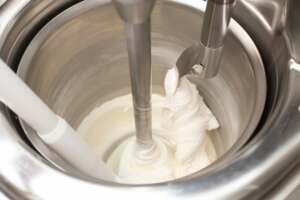When in Italy don’t look for ice cream: gelato rules!
Gelato is the great luxury that each of us can afford. The sweet parenthesis of the day that turns adults in kids. A daily cuddle that is also a moment of refreshment & consolation.
In Italy there are more than ten thousand artisan ice cream parlors (gelaterie). The so-called bar-gelateria are even more, for an induced of millions of euros. Not always, anyway, worth stopping at the first ice cream shop on the street. Gelato can be a true masterpiece or a useless source of calories, indeed.
Nothing is more necessary than the unnecesary.
My grandfather, born in 1918, tasted ice cream for the first time in 1939, when he left, as a soldier, for the Second World War. In his village, in fact, ice cream did not exist, the maximum of walking luxury was the candied apple on a stick at Christmas. When I was a child, homemade gelato was sold in kiosks near public gardens for 150 liras. There were only three flavors available: strawberry, lemon and chocolate. The cone was a very fragile tasteless wafer, which often broke, with ice cream on the ground causing big crying. For a Seventies’ child loosing the ice cream on the floor there was not a second chance, indeed. In the eighties instead, there was the boom of packaged ice cream, full of who- knows- what and artificial colors. Certainly the word quality did not guide the choices of either producers or consumers.

The Hokey pokey – in UK that’s how people used to call the vendors distorting the italian shout “ecco un poco” (there’s a little)
Calling famous gelato lovers.
From ancient times to today, gelato counted very important lovers, from Caterina de Medici to Madame de Pompadour, from Napoleon to Maria Callas. The great poet Giacomo Leopardi seems used to have impressive quantities, making glato his primary food. Dickens, Chopin, Garibaldi, D’Annunzio were also gelato admirers. Gelato has also entered the epic scenes of cinema, such as Audrey Hepburn enjoying an ice cream on the Spanish Steps in Roman Holiday. Or Julia Roberts in Eat, pray, love or even Totò in Miseria e nobiltà a classic of Italian movies.
Napoleon to Maria Callas. The great poet Giacomo Leopardi seems used to have impressive quantities, making glato his primary food. Dickens, Chopin, Garibaldi, D’Annunzio were also gelato admirers. Gelato has also entered the epic scenes of cinema, such as Audrey Hepburn enjoying an ice cream on the Spanish Steps in Roman Holiday. Or Julia Roberts in Eat, pray, love or even Totò in Miseria e nobiltà a classic of Italian movies.
Gelato & politics
It is known that the croissant was invented to celebrate the defeat of the Turks. Similarly, the Negus Cup was designed to celebrate the victories of fascist Italy in Abyssinia. It was a cup of vanilla and fruit gelato, with whipped cream and sour cherries in syrup on the top. A delight to celebrate a bad event. In the sixties in Milan an ice cream maker invented the mangia e bevi, a cup of zabaglione ice cream and fresh fruit in layers. In the seventies, the Panciera ice cream parlor in Grado – which counted the director Pasolini and the opera singer Maria Callas among its customers – launched its novelty in terms of years of lead: the Bomba. It was a cream ice cream covered with crispy chocolate, sprinkled with whiskey that was then set on fire. Maybe a way to exorcise fear?

A good gelato is made with quality ingredients, respecting seasonality
A little too much
So were also born the famous spaghetti gelato with strawberry cream on top to simulate tomato sauce. Or fake fried eggs, i.e. peaches in syrup served on a bed of vanilla ice cream. In the eighties then, there was a great display of dyes to attract children, the horrendous smurf gelato flavor and toppings of all kinds. Today, fortunately, everything is different. When looking for a good gelato, people are now going to simplicity and, even better, on seasonality. Increasingly attentive and rigorous consumers appreciate the novelty of creative tastes only if they are extremely balanced. Where you can clearly perceive the skill of the ice cream maker as well as the quality of the raw materials.
The tradition of Italian gelato: truth or legend?
So, this gastronomic wonder is really an Italian property? Basically, in Italy we consider handcrafted gelato to be Italian. In reality, it is not a matter of nationalism. The difference beyween artisan and industrial gelato lays on the making process. Firstly, ice-cream (that for italian is synonimum of industrial gelato) contains more air, more fats and less ingredients than gelato. Obviously, even if handcrafted, the gelato must be made with quality ingredients. To simplify, there are three types of gelato shops: bad, medium, excellent. And considering that ice cream is a caloric (and emotional) luxury, it is advisable to turn only to the latest. Also, the price is the same for a bad, a medium or a excellent one. There is really not reason for a bad choice.
But, what is gelato?

Quality Gelato sorbet is lactose-free and gluten-free always. Made with pure quality water and season fruit.
Literally, the word gelato means frozen. Gelato is a sweet food whose ingredients are eggs, sugar, cream or milk. When having a base of water it is named gelato sorbet. For both it is requires a refrigeration process to reach a consistent texture. So, one of the basic ingredients of ice cream is the cold. To get the cold, people needed salt. Salt, therefore, has been, for centuries, a fundamental ingredient of ice cream, more than sugar.
Gelato and sorbet: the differences
In ancient times there were some similar products to gelato. The word gelato spread out in the nineteenth century. Always used in combination with the arabic word sorbet (Sherbet) meaning snow and fruit together. Today in ice cream parlors (gelaterias) we would hardly hear someone calling the word sorbetto. The word gelato indicates indifferently both water and milk bases. Of course, sorbets are appropriately reported on the label of the displays. More for health reasons of any allergic patrons than for stylism. In fact, sorbet is always lactose-free, the milk protein that creates problems for many people. A good new is that gelato si always gluten free as well, except when having specific flavors including cookies inside, like, as example, tiramisù gelato flavor.

Ancient bar-gelateria in Pompei
The history of gelato: who invented it?
Let’s go in order: let’s jump back in time to the Arab domination on the peninsula. The Arabs loving to mix ice with fruit juices, gave their contribution to the gastronomic culture of Southern Italy. In Egypt, some hieroglyphs represent the pharaohs intent on sharing cups of crushed ice with guests. The ancient Greeks, it is known, loved to enjoy ice mixed with honey and fruit juices. The ancient Romans were also very fond of iced and chilled drinks. Ingenious as they were, ancient Romans were even able to create and preserve ice. As well as special inns where you can sell and consume cold recipes. In short, the whole Mediterranean basin was intent on finding refreshment and pleasure in sweet cups of cold.
Not only in the Mediterranean
For China and India the customs were not so dissimilar. It is known one of the most beloved flavors in the world is pistachio. We cannot fail to mention the great explorer Marco Polo. Responsible for the opening of Asiatci trade routes that brought exothic products, such as citrus fruits, pistachios, cane sugar. To be able to talk about ice cream with knowledge, in fact, we must wait for the introduction of sugar in the food system. The tradition tells that the personal cook of Catherine de Medici, following her to France as the King’s bride, with the recipe for peach sorbet made the sorbet famous at the court. So the sixteenth century opens the dances, even if the spread of consumption will be far later. We are in fact talking about the luxury of luxuries, a very expensive food and reserved only for the wealthiest.
So, is gelato born in Italy?
Well, considering that sugar and the cold technique were born in the Indies, we could say no. Anyway Italy, not yet a nation at that time, claims already to be the motherland of this delight. Probably this is due to a series of reasons. Including the richness and quality of ingredients available in the Country and the expertise, given by the various dominations. All combined with a certain, undeniable creativity that is all italian. Dowry that allows Italians, always, to make a virtue of necessity.

Le Cafè Procope in Paris: the first Gelato store of the modern times by the sicilian Procopio dei Coltelli.
The Sicilian guy who conquered the taste buds of Europe.
In 1672, the young Procopio dei Coltelli, a Sicilian guy, left for Paris to make his fortune. Procopio’s grandfather, indeed, had left him a cold machine, the first batch freezer in history. Thanks to the sorbettiera the young Procopio opened the famous Café Procope. If fortune favours the brave, Procopio was literally kissed by her. Above all, when a short time later, the Paris Opera was inaugurated right in front of his Café. Procopio, therefore, is not so much the inventor of gelato, but its innovator, or, in other words, the father of creamed ice cream. The Movement was, therefore, the magic ingredient. The twenty-year-old was endowed with great entrepreneurial skills. He made his Caffè a sumptuous place, full of Carrara marbles and Murano chandeliers. It didn’t take long to attract crowds and the place became one of the most important literary cafes in Europe.
Ice cream: nineteenth-century street food
Vienna: the richest and most populous city of the powerful Austro-Hungarian Empire. Rich in Cafes and producers, electrified, modern city. However, aware that the best master gelato makers were from Italy. The Empress Maria Theresa of Austria gave an impulse to the growing presence of venetian gelato masters, regulating street sales.. The city was literally teeming with ice cream vendors with their carts first and gelato shops later. Ice cream carts also in England, where, however, the living and working conditions of the so-called hokey pokey, were absolutely not good.

The gelato -maker bu Cattabriga in 1927 – the revolutionary patent still used today
Electricity, the new ingredient in modern ice cream
Salt and ice were refrigerants in the ancient times. But, at the end of the nineteenth century, in Austria Doctor Karl von Linde discovers the use of ammonia. Unlike Italy, Austria was a very advanced society. The city of Wien was the first one to have public electricity. Connecting the gelato maker to electricity was a smart idea. The work was so minor and much easier. In 1927 the bolognaise Otello Cattabriga, invents the most advanced batch freezer. He added the spatula to detach the ice cream from the edges of the container. Inventing an autonomous machine, from the insertion of the mixture to the moment of extraction. The modern gelato machine was born.
Ultimately
We can, therefore, argue that gelato does not have an identifiable inventor. But both the evolution of a recipe changed over time, in taste and in the combination of ingredients. What we now call Italian gelato, so it is not said will remain immutable forever. A small, great pleasure that has accompanied us for over five hundred years. And that remains one of the best cold pastry creations in the world, and we enjoy it like this.
Need A FREE BOOK GUIDE with the best of Rome Gelato stores? It is FREE for our foodies! . Book your tour or Follow us on our social media. FOOD LOVERS NEVER GET BORED!










